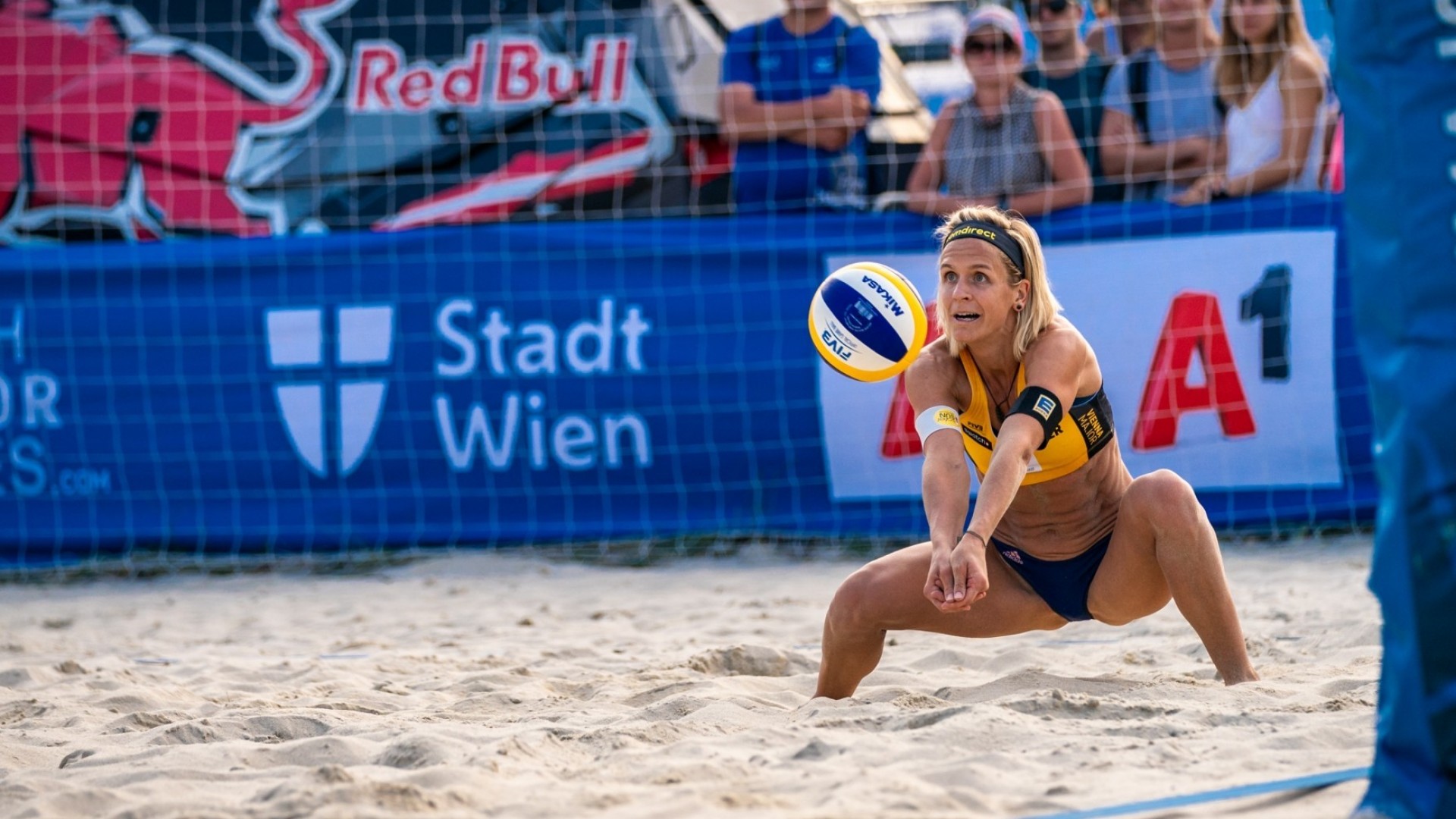Olympic Pools Breakdown – Women

07.07.2021 - Vienna, Austria

The beach volleyball pools for the Tokyo Olympics are set! The drawing of lots was concluded on Monday in Moscow and we’ve already brought you all the relevant info about it.
Now it’s time to dive a little deeper and get some insights on what to be looking for when the Olympics come in a few weeks. We start with the women, but stay tuned as the men will soon follow.
Teams: Sarah Pavan/Melissa Humana-Paredes (Canada), Joana Heidrich/Anouk Vergé-Dépré (Switzerland), Julia Sude/Karla Borger (Germany), Raisa Schoon/Katja Stam (Netherlands)
What to Expect: A pool that reunites the reigning world champions and the reigning European champions doesn’t need much else to be relevant, but the other two teams here are really strong too. Even when playing with different partners, Borger and Sude have been among the best in the world for the most part of the last decade while Schoon and Stam are on fire and have all the traits of an Olympic dark horse.
Key Match: Pavan/Humana-Paredes vs. Heidrich/Vergé-Dépré. In theory, this should be the match to determine first and second places in the pool, but considering the level of the other two teams, there’s a high probability an upset happens at some point, tuning this meeting in to a win-or-go-home situation for at least one of these two teams.
Did You Know? This pool has three of the five tallest players in the women’s tournament in Pavan (1.96m), Stam (1,94m) and Heidrich (1.90m). Standing at ‘just’ 1.85m, Sude will have to work hard against her opponents at the net.
Teams: April Ross/Alix Klineman (USA), Sanne Keizer/Madelein Meppelink (Netherlands), Liliana Fernandez/Elsa Baquerizo (Spain), Chen Xue/Xinxin Wang (China)
What to Expect: There’s a lot of experience on this pool with six of the eight players having already competed in the Olympics in the past. The Americans stand out as the favorites, but they have lost to each of their three opponents at least once over the last two years, so there’s potential for an upset here too, especially coming from the two Europeans, who have both enjoyed success at the continental and international levels.
Key Match: Keizer/Meppelink vs. Liliana/Elsa. If no upsets happen, this match should determine second and third places in the pool, which makes a huge difference. While second-placed teams go straight to the Round of 16, third-placed duos may have to play a ‘lucky loser’ match and you never know what’s coming from the other pools.
Did You Know? From all six pools, this is the only to have players who competed in the London 2012 Olympics in all four teams. Ross (second), Xue (fourth), Meppelink (ninth) and Liliana/Elsa (ninth) have all played in the event nine years ago.
Teams: Agatha Bednarczuk/Eduarda ‘Duda’ Lisboa (Brazil), Heather Bansley/Brandie Wilkerson (Canada), Fan Wang/Xinyi Xia (China), Ana Gallay/Fernanda Pereyra (Argentina)
What to Expect: The Brazilians are the clear front-runners here as they’ve been consistent over the years and always remained in the top-five in the world. The Canadians had a brilliant season back in 2018, but are still trying to get back to that level of play while the Chinese can play at a great level too, but are highly inconsistent. The Argentineans are underdogs here but don’t overlook Ana Gallay, a player who has qualified for the Olympics with three different partners.
Key Match: Agatha/Duda vs. Bansley/Brandie. These are arguably the top two teams in the pool and this should be the most entertaining match of all six that are set to happen. An interesting detail here is that the Canadians’ coach, Rico de Freitas, coached Agatha in the best period of her career, between 2011 and 2016, and knows a thing or two about her game.
Did You Know? This is the first-ever women’s pool in Olympic history without a European team. Since the pool system came in play in Athens 2004, every single women’s pool had at least one team from the continent in it.
Teams: Rebecca Cavalcanti/Ana Patricia Ramos (Brazil), Kelly Claes/Sarah Sponcil (USA), Tina Graudina/Anastasija Kravcenoka (Latvia), Gaudencia Makokha/Brackcides Khadambi (Kenya)
What to Expect: It’s hard to imagine the Kenyans would be able to take a set from any of their opponents, but between the other three teams, anything can happen. Brazilians, Americans and Latvians have all had some success at the international level but are still very young and have their ups and downs. It’s easy to predict they will take the top three spots in the pool, but impossible to determine in which order.
Key Match: Rebecca/Ana Patricia vs. Claes/Sponcil. The most interesting thing about this match is that it will reunite two teams in completely opposite moments. The Brazilians qualified early for Tokyo and haven’t played greatly as of late while the Americans are still surfing on the wave that pushed them to win back-to-back World Tour events a month ago and secure their spots in the Games.
Did You Know? This is the only pool among all six in which all eight players will be competing at the Olympics for the first time. Truth be said, outside of Rebecca, no player has even been involved in the Olympic qualification process before succeeding on their attempt to be in Tokyo.
Teams: Taliqua Clancy/Mariafe Artacho (Australia), Nadezda Makroguzova/Svetlana Kholomina (Russian Olympic Committee), Marta Menegatti/Viktoria Orsi Toth (Italy), Leila Martinez/Lidiannis ‘Lidy’ Echeverria (Cuba)
What to Expect: This is probably the pool in which the four teams are the closest when it comes to level of play. The Australians and the Russians have both won World Tour medals this year and might be the favorites to move directly to the Round of 16, but they will need to bring their absolute best game against the Italians, who have been consistently good over the years, and the Cubans, who don’t play a lot internationally but normally cause chaos when they do.
Key Match: Menegatti/Orsi Toth vs. Leila/Lidy. One thing is certain about this pool – one team that could cause damage in the elimination round won’t have a chance to do it. Odds are this will be between Italians and Cubans, so winning this match might be instrumental for remaining alive in the tournament.
Did You Know? All four teams had previous experience together before reuniting for Tokyo. The Australians played two events in 2012 before reuniting again 2017. The Russians competed in age group events in 2016 and reunited again late in 2017. The Italians were partners between 2013 and 2016 and got back together in 2018. The Cubans had their first stint together in 2017.
Teams: Miki Ishii/Megumi Murakami (Japan), Tanja Hüberli/Nina Betschart (Switzerland), Laura Ludwig/Maggie Kozuch (Germany), Marketa Sluková/Barbora Hermannová (Czech Republic)
What to Expect: The Japanese will try to use the home sand advantage to succeed in a pool that seems really difficult to them with three of the top European teams. The Swiss are probably the ones in better form right now but the Germans and the Czechs have found success at the highest level of the sport and should present strong opposition to them.
Key Match: Hüberli/Betschart vs. Ludwig/Kozuch. It will be a tough fight between the three Europeans in this pool and this will be the first match involving two of them. What happens here could impact the outcome of the entire pool as the winners will walk out of the court with a lot of confidence while the losers with have to develop a strong sense of urgency early on.
Did You Know? The reigning Olympic champion, Ludwig will try to become the first European player to win multiple medals at the Olympics. As of now, every European player who stepped on the Olympic podium failed to do it for a second time.


